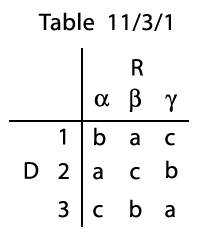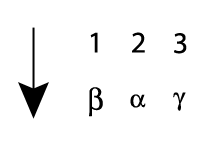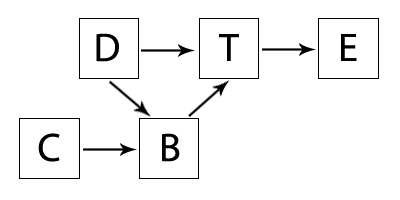In this excerpt from Introduction to Cybernetics, Ashby describes a two player game. He extends the elements of the game to derive the Law of Requisite Variety. I found The Intuitive Self embedded in his immediate effects model of the law. Added emphasis appears in red, and my reactions are enclosed in a box: (Note 64)
11/3. . . . suppose that we are watching two players, R and D, who are engaged in a game. We shall follow the fortunes of R, who is attempting to score an a. The rules are as follows. They have before them Table 11/3/1, which can be seen by both:
 |
Table 11/3/1 D must play first, by selecting a number, and thus a particular row. R, knowing this number, then selects a Greek letter, and thus a particular column. The letter specified by the intersection of the row and column is the outcome. If it is an a, R wins; if not, R loses. |
Examination of the table soon shows that with this particular table R can win always. Whatever value D selects first, R can always select a Greek letter that will give the desired outcome. Thus if D selects 1, R selects beta; if D selects 2, R selects alpha; and so on. In fact, if R acts according to the transformation then he can always force the outcome to be a. |
 |
R's position, with this particular table, is peculiarly favourable, for not only can R always force a as the outcome, but he can as readily force, if desired, b or c as the outcome. R has in fact, complete control of the outcome. . . .
| In this model, I assume the role of R where D represents things that require a response from me. The desired outcome a is to harmonize with the Tao. As R in this simple situation, I am able to make choices that insure the outcome a no matter what D does. |
11/7. If the varieties are measured logarithmically, and if the same conditions hold, then the theorem takes a very simple form. Let VD be the variety of D, VR that of R, and VO that of the outcome. Then the previous section has proved that VO cannot be less, numerically, than the value of VD - VR. Thus VO's minimum is VD - VR.
If VD is given and fixed, VD - VR can be lessened only by a corresponding increase in VR. Thus the variety in the outcomes, if minimal, can be decreased further only by a corresponding increase in that of R. This is the law of Requisite Variety. To put it more picturesquely: only variety in R can force down variety due to D; only variety can destroy variety. . . .
| Among the possible outcomes, given any action taken by D (what happens in my environment), at least one harmonizes with the Tao. As the actor R, I must choose the action that yields the outcome that achieves harmony with the Tao no matter what D does. The Intuitive Self knows which of the available outcomes given D's action harmonizes with the Tao. Listening to The Intuitive Self, I will then know which action to take. |
There is first a set of disturbances D, that start in the world outside the organism, often far from it, and that threaten, if the regulator R does nothing, to drive the essential variables E outside their proper range of values. The values of E correspond to the "outcomes" of the previous sections. Of all these E-values only a few eta are compatible with the organism's life, or are unobjectionable, so that the regulator R, to be successful, must take its value in a way so related to that of D that the outcome is, if possible, always within the acceptable set eta, . . .
| The acceptable set of outcomes E are those in harmony with the Tao. Every possible combination of D and R has at least one outcome that inherently mirrors the movement of the Tao. This set of outcome possibilities eta that are compatible with the Tao are made apparent through The Intuitive Self. |
We can look at the situation in another way. Suppose the decision of what outcome is to be the target is made by some controller, C, whom R must obey. C's decision will affect R's choice of alpha, beta or gamma; so the diagram of immediate effects is

. . . Suppose now that R is a perfect regulator. If C sets a as the target, then (through R's agency) E will take the value a, whatever value D may take. Similarly, if C sets b as target, b will appear as outcome whatever value D may take. And so on. And if C sets a particular sequence - a, b, a, c, c, a, say - as sequential or compound target, then that sequence will be produced, regardless of D's values during the sequence. Thus the fact that R is a perfect regulator gives C complete control over the output, in spite of the entrance of disturbing effects by way of D. Thus, perfect regulation of the outcome by R makes possible a complete control over the outcome by C. . . .
| In the diagram of immediate effects, D stands for what happens to me, C for The Intuitive Self, R for the part of me that takes action, T for the environmental givens (internal and external) and E for the outcome. C specifies an outcome to me (the regulator R) that it knows harmonizes with the Tao. As the actor R, I exercise my will to select the action that yields the desired outcome. To become the perfect regulator R, I must yield control to C. Perfect control requires that I bend my will to the guidance of The Intuitive Self. |
11/5. In our treatment of regulation the emphasis has fallen on its property of reducing the variety in the outcome; without regulation the variety is large - with regulation it is small. The limit of this reduction is the regulation that holds the outcome rigorously constant. This point of view is undoubtedly valid, but at first it may seem to contrast sharply with the naive view that living organisms are, in general, anything but immobile. . . .
It should be appreciated that the distinction between "constant" and "varying" often depends on the exact definition of what is being referred to. Thus if a searchlight follows an aircraft accurately we may notice either that the searchlight moved through a great range of angles (angles in relation to the earth) or that the angle it made with the aircraft remained constant at zero. Obviously both points of view are valid; there is no real contradiction in this example between "great range" and "constant", for they refer to different variables. . . .
Many of the activities of living organisms permit this double aspect. On the one hand the observer can notice the great deal of actual movement and change that occurs, and on the other hand he can observe that throughout these activities, so far as they are coordinated or homeostatic, there are invariants and constancies that show the degree of regulation that is being achieved.
Ashby's discussion of constant and varying corresponds to the Taoist insistence on wei wu wei. This paradoxical Doing Not-Doing puzzles the Western mind due to confusion over what is being referred to. A person who is doing not-doing does not sit like a statue in their office chair. Outwardly they are busy and active as the regulator R selecting and enacting first this and then that choice. No matter how many things I "do," harmony with the Tao remains constant - impassioned action accomplishing "no-thing." Episode 16 in the Tao of Managing explores this apparent contradiction. Paradoxically perfect control relative to The Intuitive Self requires complete surrender of my will to the will of the Tao. |